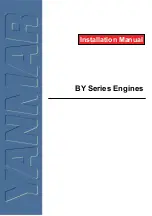
40
EFI System
KohlerEngines.com
66 690 14 Rev. A
2. Disconnect electrical connector from an injector and
listen for a change in idle performance (only running
on one cylinder) or a change in injector noise or
vibration.
If an injector is not operating, it can indicate either a bad
injector, or a wiring/electrical connection problem. Check
as follows:
1. Disconnect electrical connector from both injectors.
Plug a 12 volt noid light (part of EFI Service Kit) into
one connector.
2. Make sure all safety switch requirements are met.
Crank engine and check for
fl
ashing of noid light.
Turn key OFF for at least 10 seconds between tests
to allow ECU to go to sleep and reawake. Repeat
test at other connector.
a. If noid light
fl
ashing occurs, use an ohmmeter
(Rx1 scale) and check resistance of each injector
across two terminals. Proper resistance is 11-13
Ω
. If injector resistance is incorrect, replace
injector.
If injector resistance is correct, visually inspect
connection between connector and injector
terminals. Terminals should be free of corrosion,
wear, or dirt. If a problem is found, clean/repair/
replace as needed.
b. If no noid light
fl
ashing occurs, reattach
connectors to both injectors. Disconnect black
connector from ECU. Use an ohmmeter (Rx1
scale) and check injector circuit resistance
between black pins 5 and 15 for injector #1, and
pins 6 and 15 for injector #2. Proper resistance
should be 11-13
Ω
for each. If circuit resistance is
incorrect, check all electrical connections,
connectors, and wiring harness leads for issues.
If circuit resistance is found to be correct, injector
circuit is inactive (no noid light operation) due to
other problems within system. Test and inspect
for proper system operating voltage and
appropriate grounds. Correct or repair any
problem found.
Injector leakage is very unlikely, but in those rare
instances it can be internal (past tip of valve needle),
or external (weeping around injector O-rings). Loss
of system pressure from leakage can cause hot
restart problems and longer cranking times. Refer to
Disassembly for removal of injector.
1. Engine must be cool. Depressurize fuel system
through fuel connector.
2. Disconnect spark plug leads from spark plugs.
3. Thoroughly clean area around manifold and
injectors.
4. Remove injector bracket mounting bolts and remove
injectors from manifold. Removal of tie straps
securing fuel rail to manifold may be required. If
removed, tie straps must be replaced.
5. Position injectors over appropriate containers and
turn key switch ON to activate fuel pump and
pressurize system. Do not turn switch to START
position.
6. If either injector exhibits leakage of more than two to
four drops per minute from tip, or shows any sign of
leakage around outer shell, turn ignition switch o
ff
and replace injector as follows.
7. Depressurize fuel system through fuel connector.
Disconnect electrical connector(s).
8. Pull metal retaining clip connecting fuel injector to
fuel injector cap and remove injector(s).
9. Reverse appropriate procedures to install new
injector(s) and reassemble engine. Use new O-rings
any time an injector is removed (new replacement
injectors include new O-rings). Lubricate O-rings
lightly with oil. Torque injector bracket mounting
screws to 4.0 N·m (35 in. lb.), and intake manifold
mounting screws to 9.9 N·m (88 in. lb.).
Injector problems due to dirt or clogging are generally
unlikely due to design of injectors, high fuel pressure,
and detergent additives in gasoline. Symptoms that
could be caused by dirty/clogged injectors include rough
idle, hesitation/stumble during acceleration, or triggering
of fault codes related to fuel delivery. Injector clogging
is usually caused by a buildup of deposits on director
plate, restricting
fl
ow of fuel, resulting in a poor spray
pattern. Some contributing factors to injector clogging
include higher than normal operating temperatures, short
operating intervals, and dirty, incorrect, or poor quality
fuel. Cleaning of clogged injectors is not recommended;
they should be replaced. Additives and higher grades of
fuel can be used as a preventative measure if clogging
has been a problem.
Содержание Aegis ELH775
Страница 9: ...9 Specifications 66 690 14 Rev A KohlerEngines com Engine Dimensions Top A B A Oil Fill Cap B Radiator...
Страница 103: ...103 66 690 14 Rev A KohlerEngines com...
Страница 104: ...8 85612 60663 1 1P66 690 14 2021 by Kohler Co All rights reserved 104 KohlerEngines com 66 690 14 Rev A...
















































